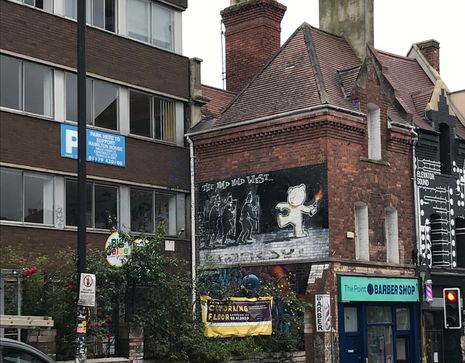Banksy: The Street Art Debate
Dulcie Whadcock explores the political nature of Banksy’s work and the questions it raises over the ownership of street art

Banksy is one of the most influential and iconic street artists of the 21st century; his satirical, witty, and politically charged stencil style is recognised across the globe and has elevated appreciation for street art among critics, art dealers, and the public. His standout street style has garnered huge interest, with his iconic pieces going to auction for tens of millions of pounds. Yet, the pseudonymous artist’s ascent to success has not come without controversy: the question of who street art belongs to, how it is valued in the present day, and whether it should be sold at all are still prevalent debates.
“Banksy’s street art is not simply a decoration, but a statement.”
Although Banksy is arguably the most recognised figure in the realm of modern-day street art, he most certainly did not invent it. In Ancient Greece, Ancient Egypt, and the Roman Empire, street art existed in the form of etchings and engravings on cave walls, from initials to storyboards to protest poems. Yet it is only recently that street art has managed to unshackle itself from the category of vandalism and gain the approval of top art critics. So why is Banksy’s work so popular? And why has street art experienced such an astronomical rise in popularity in recent decades?
Banksy’s street art is not simply a decoration, but a statement. Many of his recent works are known to taunt figures in high society: stencils such as Kissing Coppers featuring two policemen romantically embracing one another, the Devolved Parliament depicting members of parliament as chimpanzees, and Vote to Love playing on the Brexit slogan ‘vote to leave’, are just a fraction of his parodic pieces. In what Max Foster famously coined the ‘Banksy Effect’, his use of art as protest has inspired artists across the globe to take up street art to fight for their cause. Such an impact is not solely exclusive to his British roots, but worldwide; as Khatib states in her study on the ‘Banksy Effect’, his work has ‘catalysed the use of street art [as protest] in…the Arab world…[including] Libya and Syria’ (2013) too.
“Street art prides itself on its democratic nature: it is visible for all to see, for free.”
Perhaps most audaciously of all, Banksy ridicules and refuses the very art industry that attempts to adopt him. Vote to Love not only mocked the 2016 Brexit Leave campaign, but the art industry itself. Ahead of the Royal Academy showcase in 2018, Banksy entered Vote to Love under a false name, after which he received a rejection letter from the competition. He then entered the work again revealing his identity as Banksy and was welcomed onto the Royal’s walls. Although Banksy himself is yet to comment on the intention behind his resubmission, by doing so he pertinently revealed the superficiality of the art world — in which the artist’s ‘brand’ seems to prevail over the quality of the work. Secondly and most famously of all, his piece Love is in the Bin, which was set to be sold for over a million at Sotheby’s 2018 auction, self-shredded before the buyers’ eyes, obliterating the artwork to the bemusement and shock of the auction-goers. The stunt not only ridiculed the high culture of the art auctioning environment, but multiplied the value of the piece by extortionate amounts, skyrocketing its value to over sixteen million pounds.
And yet, the very notion of putting a price on street art has become controversial in recent years, with UK street artists from Banksy to Eine speaking out against the commodification of their work. Street art prides itself on its democratic nature: it is visible for all to see, for free. It is specifically placed in a significant location, its public exposure enabling its message of protest to be on display. The removal of such art from the public ‘street’ to the private ‘gallery’ removes the artist’s voice from public view and defeats the accessible ethos of the art form. As a result, both Banksy and acclaimed British street artist, Eine, continue to protest against the merchandising of their work, utilising anonymity as armour: following the non-consensual exhibition of Banksy’s work as part of the 2014 London exhibition, Stealing Banksy, he refused to claim any of the pieces as his, which consequently resulted in none of the works being sold. Similarly, acclaimed British street artist, Eine also refused to sign and authenticate his most recent works, stating, ‘[street art] is not made to be sold, but to be enjoyed’ (Shaw, 2012).
Additional controversy has erupted over the removal of Banksy’s work from its original location, with art dealer John Brandler’s purchase and removal of Banksy’s Hoola Hoop Girl from a Nottingham wall sparking fiery deliberations about who street art belongs to, and whether it should be removed and ‘protected’ from the streets or left to deteriorate naturally.
With so many conflagrant questions concerning street art, we come to wonder who has the answers, or rather, who has the right to answer. Whether it be the decision to buy or sell, protect it or abandon it, the street art debate should unquestionably be down to the artists themselves.
And as for where street art belongs? Well, the clue is in the name.
 Features / How sweet is the en-suite deal?13 January 2026
Features / How sweet is the en-suite deal?13 January 2026 Comment / Will the town and gown divide ever truly be resolved?12 January 2026
Comment / Will the town and gown divide ever truly be resolved?12 January 2026 News / 20 vet organisations sign letter backing Cam vet course13 January 2026
News / 20 vet organisations sign letter backing Cam vet course13 January 2026 Arts / Fact-checking R.F. Kuang’s Katabasis13 January 2026
Arts / Fact-checking R.F. Kuang’s Katabasis13 January 2026 Music / Inside Radiohead’s circle13 January 2026
Music / Inside Radiohead’s circle13 January 2026









